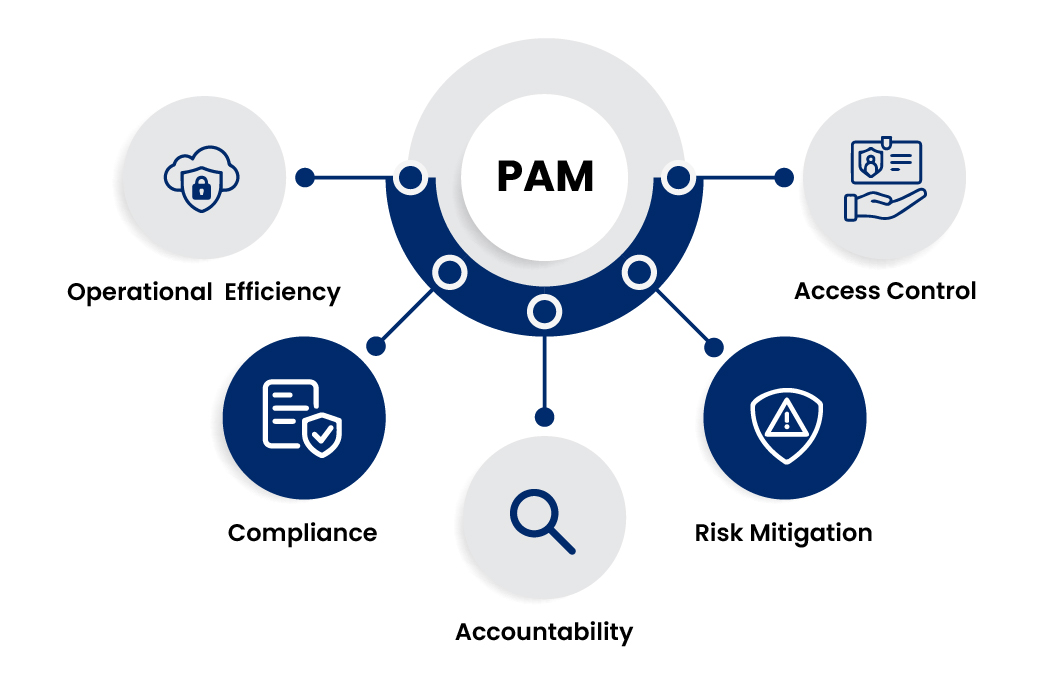Overview
Privilege Access Management (PAM) is a cybersecurity strategy and technology framework focused on securing, controlling, and monitoring privileged user access to critical systems, applications, and data. Privileged accounts, with their elevated permissions, are prime targets for cyberattacks. PAM solutions mitigate the risks linked to these accounts by enforcing stringent controls and policies, minimizing the attack surface, and ensuring accountability.
PAM is essential for industries such as government, defense, finance, and critical infrastructure, where unauthorized access to sensitive systems can result in significant operational, reputational, and financial harm.
PAM is essential for industries such as government, defense, finance, and critical infrastructure, where unauthorized access to sensitive systems can result in significant operational, reputational, and financial harm.
Key Objectives of IoT Security
Access Control
Enforce strict policies to ensure that only authorized individuals or systems access privileged accounts.
Risk Mitigation
Protect privileged accounts from misuse, insider threats, and external attacks.
Accountability
Track and monitor privileged user activities to detect and respond to suspicious behavior.
Compliance
Meet regulatory requirements such as ISO 27001, GDPR, NIST, PCI DSS, and SOX by managing and auditing privileged access.
Operational Efficiency
Streamline the management of privileged accounts without compromising security.

Components of a Privilege Access Management (PAM) Solution
- Credential Vault:
- A secure repository for storing and managing credentials such as passwords, keys, and tokens for privileged accounts.
- Features:
- Automated rotation of credentials to prevent misuse.
- Encryption to protect stored credentials.
- Session Management:
- Controls, monitors, and records privileged user sessions for accountability and forensic analysis.
- Features:
- Real-time session monitoring.
- Session replay for audit and compliance purposes.
- Just-In-Time Access (JIT):
- Grants temporary, time-bound access to privileged accounts, reducing the risk of prolonged exposure.
- Use Case:
- Providing contractors or temporary employees with limited access to critical systems.
- Role-Based Access Control (RBAC):
- Ensures users can only access the resources necessary for their roles.
- Features:
- Granular permissions to minimize over-privileged accounts.
- Multi-Factor Authentication (MFA):
- Adds a layer of security by requiring multiple forms of authentication to access privileged accounts.
- Audit and Compliance Reporting:
- Tracks all privileged account activities and generates reports to demonstrate compliance.
- Features:
- Comprehensive logs of access and actions.
- Alerts for policy violations or suspicious behavior.
- Endpoint Privilege Management (EPM):
- Limits administrative privileges on endpoints, reducing the impact of malware or insider threats.
- Integration with Security Tools:
- Seamlessly integrates with SIEM, SOAR, and IAM systems to enhance overall security posture.


Key Benefits of Privilege Access Management (PAM)
- Enhanced Security:
- Prevents unauthorized access to critical systems and reduces the risk of credential theft.
- Compliance Assurance:
- Ensures adherence to regulatory standards by enforcing robust access controls and providing detailed audit trails.
- Reduced Attack Surface:
- Minimizes the number of over-privileged accounts, making it harder for attackers to exploit.
- Operational Efficiency:
- Simplifies the management of privileged accounts and credentials across complex environments.
- Incident Response:
- Enables quick detection and mitigation of suspicious activities through real-time monitoring and alerts.
- Accountability and Transparency:
- Tracks user actions to ensure all privileged activities are visible and auditable.
Use Cases of Privilege Access Management (PAM)
- Critical Infrastructure:
- Secures access to industrial control systems (ICS) and operational technology (OT) networks.
- Government and Defense:
- Protects classified systems by limiting access to privileged accounts and monitoring user actions.
- Financial Sector:
- Prevents insider fraud and protects sensitive financial data from unauthorized access.
- Healthcare:
- Ensures secure access to patient records and medical systems.
- Enterprise IT:
- Manages administrative privileges for servers, databases, and applications.
- Third-Party Vendor Access:
- Provides temporary, secure access to contractors or partners for specific tasks.

Conclusion
Privilege Access Management (PAM) is a crucial cybersecurity strategy for protecting privileged accounts and securing sensitive systems. By implementing strict access controls, tracking user activity, and ensuring compliance, PAM helps organizations reduce risks and maintain operational integrity. With key features such as credential vaulting, session monitoring, and just-in-time access, PAM is essential for safeguarding both modern IT and OT environments.



